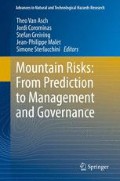Abstract
This section offers a panorama of the corrective and protection measures that might be applied for the mitigation of landslide risk. Two different strategies may be envisaged depending on whether the aim is at the reduction of the landslide hazard or of the respective consequences. Hazard reduction measures are distinguished into stabilization measures and control measures. The first category includes the stabilization measures that lead to the reduction of the driving forces or to the increase of the resistant ones, while the second one refers to the interception and control measures that diminish the landslide severity (e.g. magnitude, impact energy or pressure) or even the probability of reaching the elements at risk. Consequence avoidance includes measures for the protection of the exposed elements or even the decrease of their vulnerability, although the latter lacks in efficiency in comparison with the rest. Using this classification, a variety of mitigation measures is presented for three different landslide types: rockfalls, debris flows and landslides, the latter embracing a broad range of shallow to deep-seated slope movements, including rock slides, earth slides, earth flows or complex phenomena.
Access this chapter
Tax calculation will be finalised at checkout
Purchases are for personal use only
References
Alcoverro J, Corominas J, Gómez M (1999) The barranco de arás flood of 7 august, 1996 (biescas, central Pyrenees, Spain). Eng Geol 51:237–255
Andrew R, Bartingale R, Hume H (2011) Context sensitive rock slope design solutions. Publication No. FHWA-CFL/TD-11-002, Federal highway administration of US. http://extra.cflhd.gov/programs/techDevelopment/geotech/css. Accessed July 2011
Arattano M, Conte R, Franzi L, Giordan D, Lazzari A, Luino F (2010) Risk management on an alluvial fan: a case study of the 2008 debris-flow event at Villar Pellice (Piedmont, N-W Italy). Nat Hazard Earth Syst 10:999–1008
Brauner M, Weinmeister Agner P, Vospernik S, Hoesle B (2005) Forest management decision support for evaluating forest protection effects against rockfall. For Ecol Manag 207:75–85
Cannon SH (1993) An empirical model for the volume-change behavior of debris flows. In: Proceedings of Hydraulic Engineering, vol 2, San Francisco, pp 1768–1777
Chen H, Petley DN (2005) The impact of landslides and debris flows triggered by Typhoon Mindulle in Taiwan. Q J Eng Geol Hydrogeol 38:301–304
Corominas J (2013) Avoidance and protection measures. In: Shroder J (Editor in Chief), Marston RA, Stoffel M (eds) Treatise on geomorphology, vol 7, Mountain and hilslope geomorphology. Academic Press, San Diego, pp 259–272
Corominas J, Remondo J, Farias P, Estevao M, Zérere J, Díaz de Terán JR, Dikau R, Schrott L (1996) Debris flows. In: Dikau R, Brunsden D, Schrott L, Ibsen ML (eds) Landslide recognition. Wiley, Chichester/New York
Costa JE (1984) Physical geomorphology of debris flows. In: Costa JE, Fleisher PJ (eds) Developments and applications of geomorphology. Springer, Berlin
Crozier MJ (2005) Multiple occurrence regional landslide events in New Zealand: hazard management issues. Landslides 2:247–256
Ellingwood B, Dusenberry D (2005) Building design for abnormal loads and progressive collapse. Comput Aid Civil Infrastruct Eng 20:194–205
Fannin RJ, Rollerson TP (1993) Debris flows: physical characteristics and behaviour. Can Geotech J 30:71–81
GEO – Geotechnical Engineering Office (2003) Layman’s Guide to slope maintenance. The Government of Hong Kong, Hong Kong
Highland LM, Bobrowsky P (2008) The landslide handbook—a guide to understanding landslides, U.S. Geological Survey Circular 1325. U.S. Geological Survey, Reston, 129 p
Hoek E, Bray JW (1981) Rock slope engineering, 3rd edn. Taylor & Francis, London
Holub M, Hübl J (2008) Local protection against mountain hazards – state of the art and future needs. Nat Hazard Earth Syst 8:81–99
Hutchinson JN (1977) The assessment of the effectiveness of corrective measures in relation to geological conditions and types of slope movement. Bull Int Assoc Eng Geol 16:131–155
Izzuddin BA, Vlassis AG, Elghazouli AY, Nethercot DA (2008) Progressive collapse of multi-storey buildings due to sudden column loss – part I: simplified assessment framework. Eng Struct 30(5):1308–1318
Kliche CA (1999) Rock slope stability. Society for Mining, Metallurgy, and Exploration, Inc, Littleton, 253 pp
Prochaska AB, Santi PM, Higgins JD (2008) Debris basin and deflection berm design for fire-related debris-flow mitigation. Environ Eng Geosci 14:297–313
Revellino R, Hungr O, Guadagno FM, Evans F (2004) Velocity and runout simulation of destructive debris flows and debris avalanches in pyroclastic deposits, Campania region, Italy. Environ Geol 45:295–311
Schellenberg K, Vogel T (2007) Tests and analytical model of rockfall impacts on galleries. In: Proceedings of protect 2007, Structures under extreme loading, Aug. 20–22, Whistler
Sidle RC, Pearce JC, O’Loughin CL (1985) Hillslope stability and land use, vol 11, Water resources monograph series. AGU, Washington, DC, 140 pp
Turner A, Schuster R (1996) Landslides. Investigation and mitigation. Special report 247. National Research Council of US
Wieczorek GF, Larsen MC, Eaton LS, Morgan BA, Blair JL (2001) Debris-flow and flooding hazards associated with the December 1999 storm in coastal Venezuela and strategies for mitigation. USGS, Open-file report: ofr-01-0144. http://pubs.usgs.gov/of/2001/ofr-01-0144/
Wyllie D, Mah C, Hoek E (2004) Rock slope engineering: civil and mining, 4th edn. Taylor & Francis, London
Zanchetta G, Sulpizio R, Pareschi MT, Leoni FM, Santacroce R (2004) Characteristics of May 5–6, 1998 volcaniclastic debris fows in the Sarno area (Campania, southern Italy): relationships to structural damage and hazard zonation. J Volcanol Geoth Res 133:377–393
Author information
Authors and Affiliations
Corresponding author
Editor information
Editors and Affiliations
Rights and permissions
Copyright information
© 2014 Springer Science+Business Media Dordrecht
About this chapter
Cite this chapter
Mavrouli, OC., Corsini, A., Corominas, J. (2014). Disaster Mitigation by Corrective and Protection Measures. In: Van Asch, T., Corominas, J., Greiving, S., Malet, JP., Sterlacchini, S. (eds) Mountain Risks: From Prediction to Management and Governance. Advances in Natural and Technological Hazards Research, vol 34. Springer, Dordrecht. https://doi.org/10.1007/978-94-007-6769-0_11
Download citation
DOI: https://doi.org/10.1007/978-94-007-6769-0_11
Published:
Publisher Name: Springer, Dordrecht
Print ISBN: 978-94-007-6768-3
Online ISBN: 978-94-007-6769-0
eBook Packages: Earth and Environmental ScienceEarth and Environmental Science (R0)

